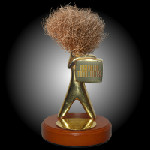Thank God You’re Back
As probably the only Australian comedy format of the 21st century with any nostalgic value attached to it (can’t wait for the Randling revival), we shouldn’t have been surprised that Thank God You’re Here finally made a comeback. But did the magic return with it?

Well, that depends: was there ever any magic there in the first place? Much as the show was much-loved, it didn’t take long to figure out the main appeal was seeing very funny people put into a situation where they found it extremely difficult to be very funny. A few people made it work; most struggled.
And so it proved to be on the first episode back after 15 or so years. Each of the four solo segments plus the group challenge (the fake ads and sketches they used to throw in between segments were nowhere to be found) had their moments. They also had a lot of awkward and sometimes painful flailing about from people we’ve seen be a lot funnier just about everywhere else.
Look, it’s totally possible that what the no doubt massive audience wants to see is funny people taken down a peg or two by being stuck in a situation where they’re on the back foot. Us? When you’ve got a cast like Urzila Carlson, Aaron Chen, Julia Zemiro and Mark Bonanno, why would you do anything that got in the way of them being funny?
While the sketch ideas were well constructed and the support cast (many of whom were back from the original) kept things moving along, it’s still a show built around asking very funny people to instantly come up with the next word in a sentence. It’s difficult and stressful for anyone, especially in front of a huge live audience. For comedians used to scripting their own material? Tough ask.
Ironically, our long-standing issue with TGYH has been that it’s an improv show that doesn’t leave any room for improv. People are fed a set-up for a line, they say something hopefully funny, here comes the next set-up. There are firm barriers in place to prevent the sketch from going off the rails; ironically the funniest moment of the night was when Aaron Chen gave an answer that meant the next set-up didn’t work (or worked too well).
But if you’re going to do an improv show, do an improv show. Let the contestants come up with their own ideas on where things should go, and have sketches that rely on their skills (and allow them to push things in directions where they can be funny). TGYH just asks them to come up with the next word in a sentence; no matter what they say, the support cast will pull things back on script.
You can stuff up and be unfunny with one line, but then the sketch resets and you get another chance. The bad news is, you can only be so funny; the good news is, you can only fail so badly. Once you’ve seen a few episodes, you know what you’re going to get – unless there’s a real off-the-cuff expert on the stage, which going by the original series happens about once every three episodes. Not a great strike rate.
Still, this first show had more than enough polish to come across as a win. Ceclia Pacquola and Glenn Robbins unsurprisingly proved to be very safe pairs of hands. But there’s no escaping the fact that there were a lot of points during the segments where the cast – again, all very funny people – just didn’t come up with funny stuff.
Again, maybe that’s what the audience wants to see. A big part of the show is the “live” atmosphere, and failing is a big part of the risk that gives the whole thing its energy. But there’s a difference between “energy” and “funny”.
And this is a show that too often doesn’t seem focused enough on the funny.
